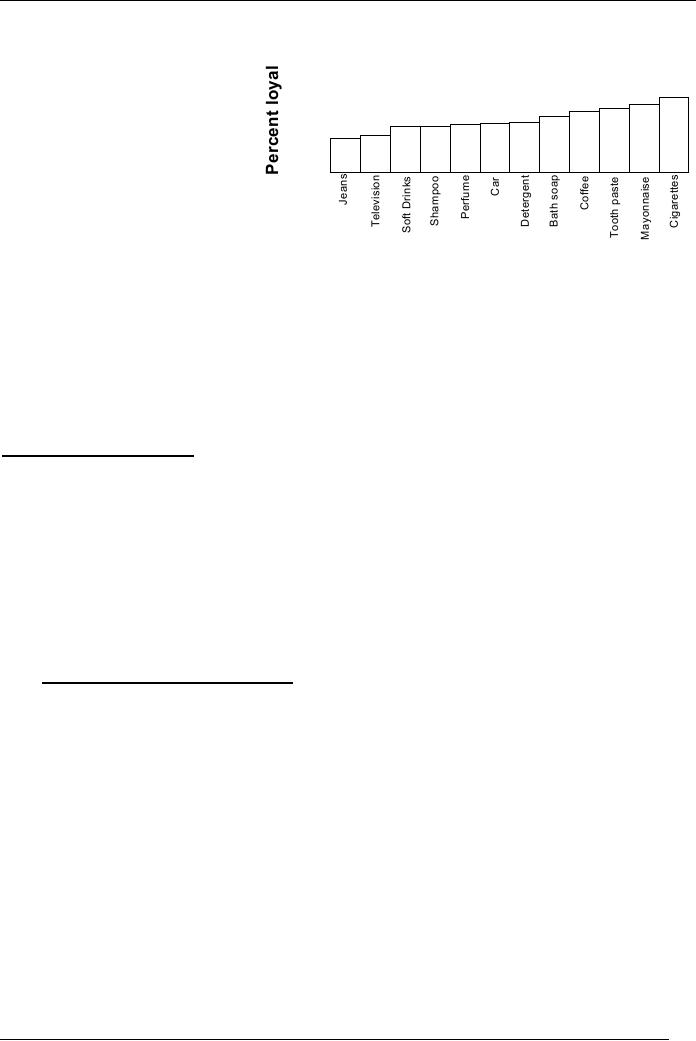 |

Brand
Management (MKT624)
VU
Lesson
14
BRAND
CONTRACT
Brand
contract principles
The
remaining three principles
are discussed in this
lecture.
2.
Translate into
standards
There
are a host of activities
that are to be undertaken
before you put a product
together.
This
implies you are putting
together different promises. Not one
department is involved
in
carrying out a task that is as
comprehensive as putting a product
together. The
numerous
activities, therefore, have to be
standardized by ensuring optimal and
accurate
input
from every employee of all
departments, starting with
purchasing right
through
production
and selling.
Well-coordinated
actions will result from
standardization of activities and lead to
meeting
promises
as made. If we go back to the example of
sandwiches, all actions
involved from
product
preparation to delivery have to be
standardized under a common set of
guidelines
production, delivery, sales, and
transportation. One action
out of the standards can
land
the
company into trouble by
affecting one or a set of promises the
company has
explicitly
made
with its customers.
All
standardized actions are the
touch points brand management
has with other
functions.
They
must converge, so that you
can uphold your contract. Any
lapses at the cold
storage
in
terms of maintenance of the
requisite temperature will lead to abuse
of meat quality.
Inefficient
transportation of ingredients may
cause delays in preparation and
delivery of
product.
Lack of training of staff
may not keep the
service as pleasant as the
company
may
claim. These possibilities exemplify
the need for all to
work like a cohesive whole
in
which
all actions are repeated
accurately according to standards
day in and day out.
3.
Fulfill Good Promises
Once
standards are in place, it is
the job of managers to
develop a standards-compliant
culture.
Such a culture keeps all
checks in place and prevents people from
omitting major
as
well as minor tasks. Companies should
not become complacent at
this juncture and
leave
things to juniors or chances in
the hope that all systems
are being followed.
Systems
and
procedures being in place is no guarantee of
compliance of standards. Strict
adherence
to procedures is even more important
than constituting those
procedures.
Execution
is gaining more and more
importance nowadays even
more than strategies.
Management
must involve itself to ensure
adherence of all procedural
tasks to the
standards
for fulfillment of promises.
Fulfillment
of good promises, at times, escapes
attention because management is
shifting
its
business strategy. Shift
comes in shape of expansion of business,
a major change in
distribution,
or entry into a new line
altogether. It is here that commitment
of
management
as part of brand vision
counts. The example of
business expansion
through
adding
restaurants to its line expresses
this phenomenon. The company
has to ensure that
existing
good promises keep getting translated
into benefits and the new
ones get
absorbed
into the basket of benefits
offered to customers.
In
case of a new offer, if the
new line is pursued in more
enthusiasm than the promises
of
the
existing brand require, then
you may damage your
brand.
4.
Uncover Bad Promises
Through
a consistent contact with
the marketplace and through
research studies, one can
easily
uncover the negative promises.
Once uncovered, the strategy
to fix those and turn
59

Brand
Management (MKT624)
VU
them
into good promises should not be
difficult. One must convert
the shortcomings into
strengths.
Summary
lecture 13 and brand contract
part of lecture14
Brand
contract is a function of promises made
and fulfilled. Companies have to be very
careful
in
making promises, for the promises
not fulfilled turn into
negative promises and can
undermine
the brand's
reputation.
The
whole company should be
involved while it puts
together the promises to be delivered,
for
that
constitutes upholding the
contract. There are four
fundamental principles that
guide us to
develop
a brand's contract. First of
all, we must understand the
customer's perspective and
then
get
on to developing features that
are full of promises. We, then,
should move on to
developing
standards
for delivering the promises and
follow that step with
fulfilling good promises. We
must
not forget to undertake an
effort to unearth any bad
promises that the contract
may carry
with
it.
In
short, understand the good promises.
Communicate them to customers,
identify new
promises
that may improve the
brand contract, uncover the
negative ones, fix them, and
then
develop
brand contract.
CRAFTING
A BRAND-BASED CUSTOMER MODEL
The
intention of developing a brand-based
model is to understand the
beliefs and behavior of
customers.
This understanding leads us to
determine why customers buy
what they buy.
This
also
makes us understand buyers'
underlying motives for
taking the decisions they take to
buy
brands
of their preference. With
the intention to win over
customers and retaining them
over a
long
period of time, we study
their purchasing actions
toward our brands and those of
competitors.
The
behavior of buyers goes
under a change with changing
circumstances. And, so do
their
beliefs.
This evolution dictates that brands also
change and correspond to the
changing
behavior
of buyers. It is for this
reason that brands also are
kept contemporary so that
they can
respond
to customers' evolving behavior. If a
company does not do that,
competition will take
over.
In
an attempt to keep customers
loyal and to prove that
their needs and beliefs are
paramount,
companies
innovate and achieve differentiation.
Since everyone follows the
same thinking,
innovations
become market standards and
all competitors follow suit
with similar brands of
good
quality. Eating into the
area of differentiation, competitors
try to erase the advantage
that
your
brand enjoys. This becomes a
challenging question for
brand managers, who have to
have
an
answer to this
challenge.
The
model should conform to value
pyramid
The
answer lies in making your
brand so powerful that
customers can emotionally
relate
themselves
with it. Brand at the
top of the brand value
pyramid conforms more to a
brand-
based
model. Staying at the
pinnacle of the pyramid
involves the process of
continuously
renewing
the brand difference. This
renewal rejuvenates the
brand and keeps it
contemporary,
and,
hence, stays as the basis of
customer preference.
Continuously
renewing the difference
makes your product more
acceptable, for it is perceived
as
the one conforming to the
changing behavior and beliefs of
customers. In most of
the
consumer
products categories, the percentage of
customers who are loyal to
just one brand is
not
very high, and that places
good brands with differentiating and
evolved features at a
fairly
decent
level of acceptability. Figure 20
testifies this
phenomenon1.
60

Brand
Management (MKT624)
VU
The
higher the percentage
of
U
s e rs L o y a l to O n e B ra n d
loyal
customers to just one
brand,
In
p erce n t
the
more sensitive is the
decision
Figure
20
to
bring about a change in
that
brand.
Those who smoke will
agree
that a change in package
design
of a cigarette pack may be
71
58
61 65
44
44 46
47 48 53
perceived
as a change in the taste
33
35
profile
of the smoke. Such a
perception
may throw the
brand
out
of consumers' favor.
Loyalty
to
one brand in the category
of
cigarettes
is the highest 71%
as
per
the above graphics.
P
ro d u c ts
Conversely,
changes in fashion
Source:
W all Street Journal October
19, 1989
jeans
may provide
brand
managers
with opportunities to gain
more customers, for not
more than 33% of customers
are
loyal
to just one brand. This also
makes room for other brands
in the market.
Continuous
rejuvenation
of brands is important so that you can
stay within the favorable
limits of the
customers
who look for points of
difference.
Three
primary questions
The
brand-based model answers three questions
relating how and what sides
of customer
decisions2.
1.
How do consumers choose one
brand over another?
2.
How does your brand stack up
against competition?
3.
What opportunities exist for
brand growth and
expansion?
Question
1
To
answer this question, we
have to be clear about three
factors:
a.
We must know what customer
buying criteria is
b.
We must rate that
criteria
c.
We must know who makes
buying decisions
Factor
a - customer buying
criteria
The
criteria for buying relate
to all attributes that a
brand carries with
it.
Most
of the attributes are price,
easy availability, convenience,
quality, good history,
innovativeness
(for manufactured goods), consistent
performance, fit with
customer's
personality,
good relationship at personal level, good
representatives, past experiences,
length
of relationship, and advertising to name a
few important ones. These
factors have
been
cited in most of the
consumer research models
and, hence, should be taken
seriously.
Customer-friendly
attributes generate trust
among customers. Trust runs
across all the
attributes
that create it. If customers
believe in the quality of
your brand, they will
perceive
the price right, believe it
will give them consistent
performance, and develop a
good
relationship with the brand.
Trust implies that customers
know what they are
going
to
buy and therefore needs to be
built.
Bibliography:
1.
Geoffery Randall: "Branding A
Practical Guide to Planning
Your Strategy";
Kogan
Page (41)
2.
Scot
M. Davis: "Brand Asset
Management Driving Profitable
Growth through
Your
Brands"; Jossey-Bass, A Wiley
Imprint (93)
61
Table of Contents:
- UNDERSTANDING BRANDS – INTRODUCTION:Functions of Brand Management, Sales forecast, Brand plan
- INTRODUCTION:Brand Value and Power, Generate Profits and Build Brand Equity
- BRAND MANIFESTATIONS/ FUNDAMENTALS:Brand identity, Communication, Differentiation
- BRAND MANIFESTATIONS/ FUNDAMENTALS:Layers/levels of brands, Commitment of top management
- BRAND CHALLENGES:Consumer Revolt, Media Cost and Fragmentation, Vision
- STRATEGIC BRAND MANAGEMENT:Setting Objectives, Crafting a Strategy, The Brand Mission
- BRAND VISION:Consensus among management, Vision Statement of a Fast Food Company, Glossary of terms
- BUILDING BRAND VISION:Seek senior management’s input, Determine the financial contribution gap
- BUILDING BRAND VISION:Collect industry data and create a brand vision starter, BRAND PICTURE,
- BRAND PICTURE:Brand Value Pyramid, Importance of being at pinnacle, From pinnacle to bottom
- BRAND PERSONA:Need-based segmentation research, Personality traits through research
- BRAND CONTRACT:The need to stay contemporary, Summary
- BRAND CONTRACT:How to create a brand contract?, Brand contract principles, Understand customers’ perspective
- BRAND CONTRACT:Translate into standards, Fulfill Good Promises, Uncover Bad Promises
- BRAND BASED CUSTOMER MODEL:Identify your competitors, Compare your brand with competition
- BRAND BASED CUSTOMER MODEL:POSITIONING, Product era, Image Era, An important factor
- POSITIONING:Strong Positioning, Understanding of components through an example
- POSITIONING:Clarity about target market, Clarity about point of difference
- POSITIONING – GUIDING PRINCIPLES:Uniqueness, Credibility, Fit
- POSITIONING – GUIDING PRINCIPLES:Communicating the actual positioning, Evaluation criteria, Coining the message
- BRAND EXTENSION:Leveraging, Leveraging, Line Extension in detail, Positive side of line extension
- LINE EXTENSION:Reaction to negative side of extensions, Immediate actions for better managing line extensions
- BRAND EXTENSION/ DIVERSIFICATION:Why extend/diversify the brand,
- POSITIONING – THE BASE OF EXTENSION:Extending your target market, Consistency with brand vision
- DEVELOPING THE MODEL OF BRAND EXTENSION:Limitations, Multi-brand portfolio, The question of portfolio size
- BRAND PORTFOLIO:Segment variance, Constraints, Developing the model – multi-brand portfolio
- BRAND ARCHITECTURE:Branding strategies, Drawbacks of the product brand strategy, The umbrella brand strategy
- BRAND ARCHITECTURE:Source brand strategy, Endorsing brand strategy, What strategy to choose?
- CHANNELS OF DISTRIBUTION:Components of channel performance, Value thru product benefits
- CREATING VALUE:Value thru cost-efficiency, Members’ relationship with brand, Power defined
- CO BRANDING:Bundling, Forms of communications, Advertising and Promotions
- CUSTOMER RESPONSE HIERARCHY:Brand-based strategy, Methods of appropriations
- ADVERTISING:Developing advertising, Major responsibilities
- ADVERTISING:Message Frequency and Customer Awareness, Message Reinforcement
- SALES PROMOTIONS:Involvement of sales staff, Effects of promotions, Duration should be short
- OTHER COMMUNICATION TOOLS:Public relations, Event marketing, Foundations of one-to-one relationship
- PRICING:Strong umbrella lets you charge premium, Factors that drive loyalty
- PRICING:Market-based pricing, Cost-based pricing
- RETURN ON BRAND INVESTMENT – ROBI:Brand dynamics, On the relevance dimension
- BRAND DYNAMICS:On the dimension of knowledge, The importance of measures
- BRAND – BASED ORGANIZATION:Benefits, Not just marketing but whole culture, Tools to effective communication
- SERVICE BRANDS:The difference, Hard side of service selling, Solutions
- BRAND PLANNING:Corporate strategy and brands, Brand chartering, Brand planning process
- BRAND PLANNING PROCESS:Driver for change (continued), Brand analysis
- BRAND PLAN:Objectives, Need, Source of volume, Media strategy, Management strategy